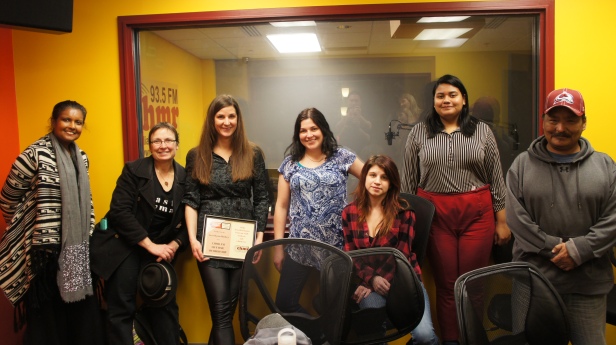This year, CHMR-FM has been hosting a Media Workshop Series, bringing in experienced journalists and broadcasters from a diversity of backgrounds and experiences to share their insights and experience with our student and community volunteers. In this blog we share some of the insights and points that arise in the workshops. On February 6, 2018, CHMR welcomed Gerri Lynn Mackey, on-the-spot news reporter with VOCM. Notes compiled by Hans Rollmann.
Gerri Lynn Mackey grew up in St. John’s but moved to Corner Brook to pursue a Bachelor of Fine Arts degree at Grenfell College. After graduating, she spent some time doing performance art but wasn’t happy at having to work retail to make ends meet, and so she applied to CFCB, VOCM’s station in Corner Brook. Within a couple of days, she was on the air.
“We were baptized by fire, which is classic for the radio world,” she recalls with a laugh.
She started off covering traffic and filling in elsewhere as needed, but soon discovered she had a real aptitude for news.
“I was really nosy,” she recalled – but this meant more often than not she knew where the stories were happening and was frequently nearby when they did. Fred Hutton was news director at VOCM at the time and encouraged her in cultivating her reporter’s skills. When a position opened in St. John’s, she moved back to the capital, and the rest is history.
People hate you
“When you’re an on-the-spot reporter, people hate you,” she admits. “You’re there reporting under trying circumstances. You have to come to an agreement with yourself not to take it personally.”
At times, people will lash out in hostile ways toward the reporter – either in person or electronically.
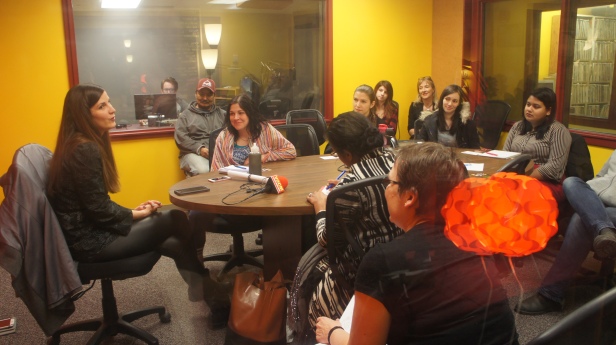
“You just have to take it,” she says. If things get extreme, you can block people online, but that’s a last resort. In commercial radio, broadcasters must often get permission to block people, because of the nature of advertising arrangements.
Mackey is rarely without VOCM swag, and it’s for a reason – the logo instantly identifies her as media. When she hits the road she’s sure to “logo up” – identifiable VOCM hat, jacket, shirt, lanyard. There’s no mistaking the fact that she’s on the job. As for gear, she plugs a mic into her cellphone and is good to go. She credits VOCM tech Sean Basha with helping the station’s reporters stay on top of their game; she tends to use the Twisted Wave app for production and editing work as necessary.
On the spot and ready to go
One of the obligations of being an on-the-spot reporter, she notes, is that she’s constantly on call and has to be ready – and sober – to head out in pursuit of a story at a moment’s notice. She tries to ensure she always has two fully charged phones and a charged iPad ready at any given time. On especially cold and icy days, she periodically ices off and warms up her car so that it’ll be ready to roll out if she gets a call to go on assignment. The extra time it takes to ice off a windshield could mean the difference between getting a story…or not.
“Once you’re in the on-the-spot reporting world, it’s a constant race,” she reflects.
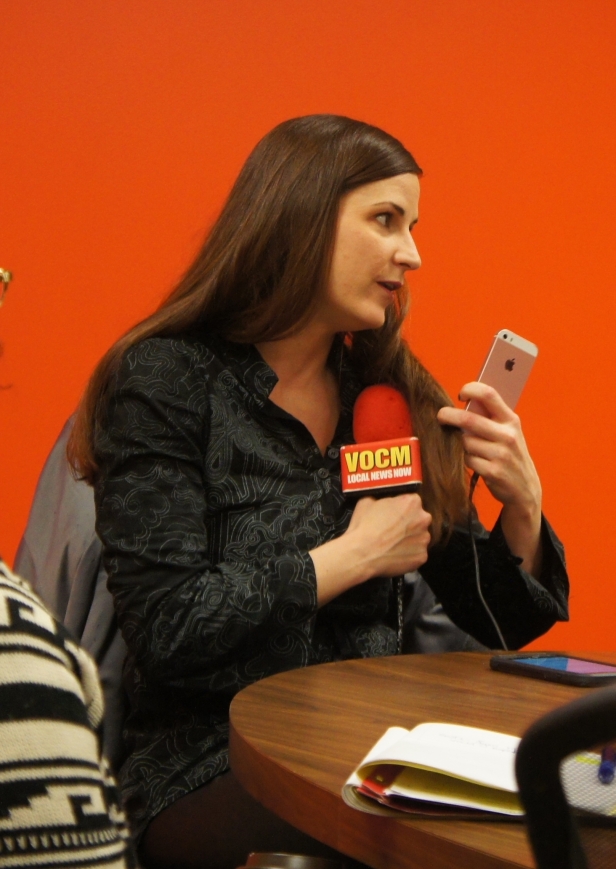
It also means being physically prepared for a variety of unpredictable environments. For radio workers who are accustomed to studio work, the physically gruelling demands of on-the-spot reporting can come as a bit of a surprise. When Mackey heads out to cover a story, she makes sure she’s packed in her car an extra Gore-Tex jacket shell, a pair of lace-up boots, a pair of hiking boots, a reflective jacket, thin gloves that she can type through, thick gloves to keep her warm, sunscreen and hand sanitizer, as well as chargers and charging cables galore.
When she heads out of town to cover a story, it’s more important to have extra clothes than extra food, she says. In rural Newfoundland, everyone is quick to offer you food and snacks, she observes, but it’s less likely they’ll have an extra jacket or pair of boots lying around to offer.
When heading out to cover a story, it’s important to map out your route first. Don’t rely on Google apps, she warns – they’re notoriously misleading. Make sure you know exactly where you’re going – taking a few minutes to ensure that you do can help you avoid many more minutes of lost driving.
Be aware of your surroundings. Mackey recalls one incident when she and a number of other reporters were searching for the source of a chlorine leak in rural Newfoundland, and no one knew the location. While others phoned for advice, Mackey looked around her. By finding and following tire tracks in the mud, Mackey was able to locate the hidden industrial access road and get to the story first.
The fruits of nosiness and being curious are real, says Mackey, even if reporters refer to it by the more professional term ‘journalistic instinct.’
Be aware and live in the moment
Being conscious and curious about what’s going on around you can lead to unexpected opportunities for a reporter. Mackey recalls once having a bad day and heading home feeling depressed and irritated. As she was driving past Boncloddy Street, she noticed a number of police cars, and that they were barricading the street. Hopping out of her car, she found herself in the middle of a police raid on the Vikings motorcycle club. The cops were astonished that she got there so quickly, but in reality it was a complete fluke, a result of her keeping her eyes open and following her curiosity.
When it comes to interviewing, she doesn’t like giving people a heads up about the questions she’s going to ask. “It sucks the life out of the interview,” she says.
The most important – and difficult – thing for a reporter to do is to actually listen to what people are saying, she reflects.
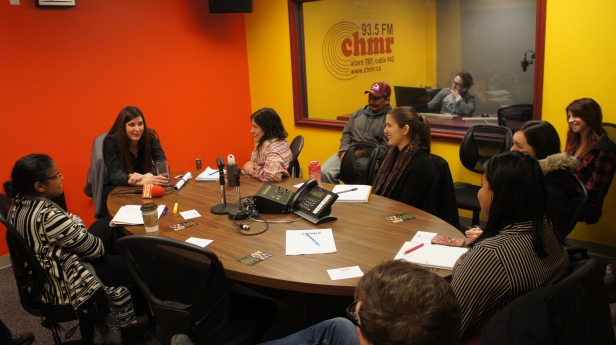
“It’s hard to listen all the time. It’s easy to zone out,” she admits. But listening closely means that the most important information you can learn might not be so obvious. “Sometimes people don’t put the important information where it’s easy to hear it. Listening is an art.”
Another important piece of advice for reporters is to “live in the moment,” she says. She was one of the many reporters covering the infamous Chase the Ace marathon in the Goulds. As soon as each game was over, most reporters dashed to their cars to try to head home. But given the enormous crowds and parking problems, it was guaranteed they’d be sitting in a line of cars for an hour or more. So rather than dashing out to try to get home – what was the point, when you’d just be sitting in your car? – Mackey chose to stick around and chat with people. As a result, she was the only reporter around when the fight broke out over duplicate printed tickets. Taking the time to be social and engage with people, rather than dashing in and out in pursuit of a story, often brings benefits to the journalist.
When she leaves town to cover a story, she says it’s important to accept and acknowledge that as a reporter, you’re the outsider. Be honest about it. Nod and greet people, take time to chat. Always be friendly. You’re the stranger entering their community, so be respectful and open to learning. In rural areas, convenience stores are a gold mine of information, she notes.
Be nosy. Be curious.
You can’t get the story from your car, she advises. You have to be nosy and curious, and you can’t be afraid. Ask questions, and talk to people. She found her art school training unexpectedly helpful in this regard.
“In art school, they teach that you get better luck asking forgiveness than permission,” she recalls. “If you ask, they’ll probably say no.” She found the attitude inculcated by her art training translated well into journalism.
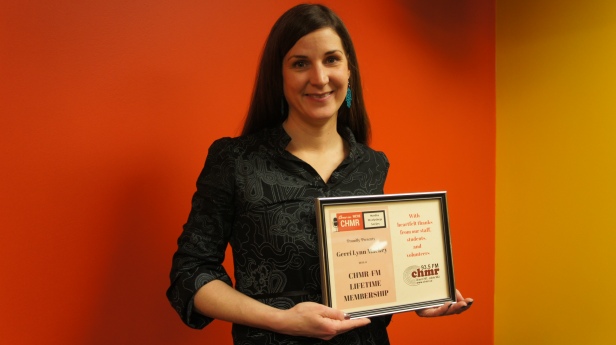
At the same time, she reflects, there are points when you should ask. She recalls the impromptu rally that took place in the wake of the Snelgrove verdict, where a police officer charged with sexual assault was acquitted. Emotions were high at the rally, and she recognized this, always asking permission before taking a photo. She recalled a male colleague who was berated by the crowds for failing to do so. It takes a certain degree of instinct and common sense to know what to do in a given situation, she notes. In this case, asking helped, and the women at the rally indicated their appreciation.
Retaining and knowing your sources is important, she advises. She puts every contact into her phone. After covering an event, she’ll usually study each photo and tweet, trying to pick out individuals and recall their names and identities. This helps her learn who’s who and remember people – knowledge that’s usually helpful down the road. Remembering people is an important and vital skill for a reporter, she emphasizes.
She acknowledges the difficulty of remaining neutral in some of the circumstances under which she’s reported. “It’s probably the hardest thing,” she admits. Holding back her disgust at certain events can be hard, but “your colleagues keep you in check,” she says. At the same time, there’s nothing wrong with reporters being human – she’s certainly cried at her share of vigils, she acknowledges.
Being a live, on-the-spot reporter inevitably means that you’ll wind up saying something, sometime that you’ll regret or feel bad about. “You learn,” she says, “But you’re never immune. On live radio anything can happen.”
But live reporting can have its wonderful and memorable moments too.
“I once drove in a limo with a three-legged cat named Trooper. To see a Trooper concert,” she laughs. A family had adopted a rescue cat which lost a leg due to frostbite, and in honour of its hardy survival they named it Trooper. When the band of the same name found out, they sent a limo to drive the cat from Stephenville to Pasadena to meet them. Mackey was invited along for the ride.
“That doesn’t happen in any other province,” she laughs. “You gotta love it.”
NOTE: The next media workshop is Thursday, March 8, at 12:00pm noon featuring CBC’s Anthony Germain! All welcome – free of charge! Don’t miss it!
